2011 HONDA FIT fuel cap
[x] Cancel search: fuel capPage 5 of 356

Your Vehicle at a Glance(main controls)....................................................................................................................3
Driver and Passenger Safety (seat belts, SRS, and child protection) ...........................................................................5
Instruments and Controls(indicators, gauges, dashboard, steering wheel, and other convenience items)
..............57
Features(heating and cooling, audio, steering wheel, security, and cruise control) ................................................109
Before Driving(fuel, vehicle break-in, and cargo loading) .......................................................................................199
Driving(engine and transmission operation) ...........................................................................................................215
Maintenance(minder, fluid checking, minor services, and vehicle storage) ...........................................................245
Taking Care of the Unexpected(flat tire, jump starting, overheating, and fuses) ...................................................285
Technical Information(vehicle specifications, tires, and emissions controls)
........................................................317
Warranty and Customer Relations (U.S. and Canada only) (warranty and contact information)........................333
Index ..............................................................................................................................................................................
I
INDEX
Service Information Summary(fluid capacities and tire pressures) ............................................................... last page
Contents
1
2011 Fit Online Reference Owner's Manual
Page 6 of 356
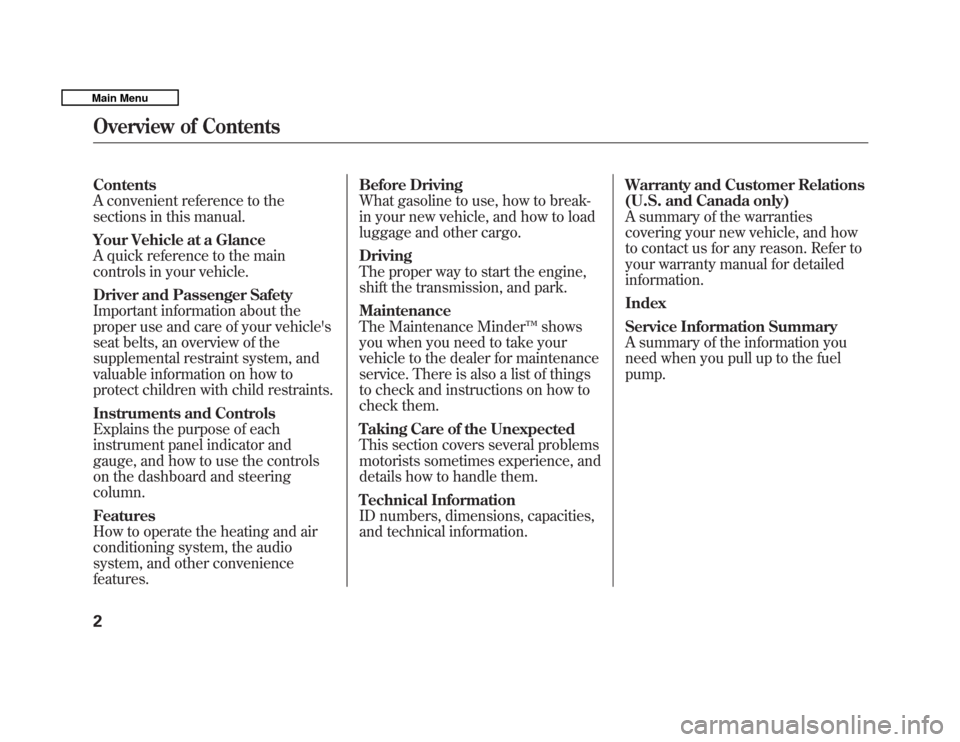
Contents
A convenient reference to the
sections in this manual.
Your Vehicle at a Glance
A quick reference to the main
controls in your vehicle.
Driver and Passenger Safety
Important information about the
proper use and care of your vehicle's
seat belts, an overview of the
supplemental restraint system, and
valuable information on how to
protect children with child restraints.
Instruments and Controls
Explains the purpose of each
instrument panel indicator and
gauge, and how to use the controls
on the dashboard and steeringcolumn. Features
How to operate the heating and air
conditioning system, the audio
system, and other conveniencefeatures.Before Driving
What gasoline to use, how to break-
in your new vehicle, and how to load
luggage and other cargo. Driving
The proper way to start the engine,
shift the transmission, and park. Maintenance
The Maintenance Minder
™shows
you when you need to take your
vehicle to the dealer for maintenance
service. There is also a list of things
to check and instructions on how to
check them.
Taking Care of the Unexpected
This section covers several problems
motorists sometimes experience, and
details how to handle them.
Technical Information
ID numbers, dimensions, capacities,
and technical information. Warranty and Customer Relations
(U.S. and Canada only)
A summary of the warranties
covering your new vehicle, and how
to contact us for any reason. Refer to
your warranty manual for detailedinformation. Index
Service Information Summary
A summary of the information you
need when you pull up to the fuelpump.
Overview of Contents
2
Main Menu
Page 61 of 356

This section gives information about
the controls and displays that
contribute to the daily operation of
your vehicle. All the essential
controls are within easy reach.Control Locations
..........................58
Instrument Panel ..........................59
Instrument Panel Indicators ..........60
Gauges .......................................... 68
Trip Meter ................................ 69
Instant Fuel Economy ...............70
Average Fuel Economy .............70
Odometer .................................. 70
Fuel Gauge ............................... 70
Check Fuel Cap Indicator .........70
Maintenance Minder ™.............. 71
Controls Near the Steering
Wheel ....................................... 72
Windshield Wipers and Washers ................................ 73
Windshield Wipers ...................73
Rear Window Wiper and
Washer ................................. 73
Turn Signal and Headlights ..........74
Instrument Panel Brightness ........76
Hazard Warning Button ................76
Rear Window Defogger .................76
Steering Wheel Adjustments .........77
Keys and Locks .............................
78Immobilizer System
......................
79
Ignition Switch .............................. 80
Door Locks ................................... 81
Power Door Locks ....................82
Childproof Door Locks ..............83
Auto Door Locking/
Unlocking ............................. 83
Auto Door Locking ...................83
Auto Door Unlocking ................86
Tailgate ......................................... 88
Remote Transmitter ......................90
Seats ............................................. 93
Power Windows .......................... 100
Mirrors ....................................... 101
Parking Brake ............................. 103
Interior Convenience Items .........104
Lower Glove Box ....................105
Upper Glove Box .....................105
Beverage Holders ...................106
Seat Under Box .......................106
Accessory Power Socket .........106
Sun Visor ................................ 106
Interior Lights ............................. 107
Instruments and Controls
57
Instruments and Controls
Main MenuTable of Contents
Page 72 of 356
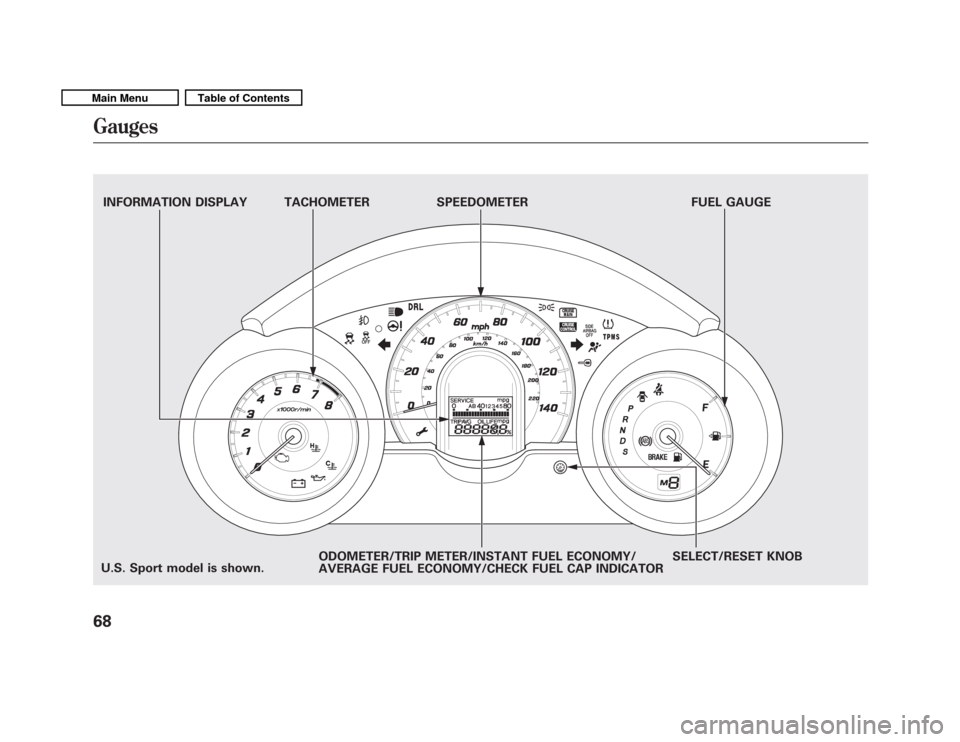
TACHOMETER SPEEDOMETER FUEL GAUGESELECT/RESET KNOB
INFORMATION DISPLAY
ODOMETER/TRIP METER/INSTANT FUEL ECONOMY/
AVERAGE FUEL ECONOMY/CHECK FUEL CAP INDICATOR
U.S. Sport model is shown.
Gauges
68
Main MenuTable of Contents
Page 74 of 356

Instant Fuel Economy
This shows your instant fuel
economy in mpg (U.S.) or l/100 km(Canada).
Average Fuel Economy
This shows your vehicle's average
fuel economy in mpg (U.S.) or 1/100
km (Canada) since you last reset the
trip meter.
When you reset a trip meter, the
average fuel economy for that trip
meter also resets.Odometer
The odometer shows the total
distance your vehicle has been
driven. It measures miles in U.S.
models and kilometers in Canadian
models. It is illegal under U.S.
federal law and Canadian provincial/
territorial regulations to disconnect,
reset, or alter the odometer with the
intent to change the number of miles
or kilometers indicated.
Fuel Gauge
This shows how much fuel you have.
It may show slightly more or less
than the actual amount. The needle
returns to the bottom after you turn
off the ignition.
Avoid driving with an extremely low
fuel level. Running out of fuel could
cause the engine to misfire, damaging
the catalytic converter.Check Fuel Cap Indicator
If the fuel fill cap is loose or missing,a
‘‘CHECK FUEL CAP ’’message
appears on the information display
after you start the engine. The
message changes from CHECK, to
FUEL, to CAP repeatedly.
Turn the engine off and confirm the
fuel fill cap is installed. If it is, loosen
the cap, then retighten it until it
clicks at least once. You can cycle the
message off of the display by
pressing the select/reset knob
repeatedly, but this message will be
displayed each time the engine is
started. It will take several days of
normal driving for the vehicle to turn
the warning off.
Gauges
70
Main MenuTable of Contents
Page 75 of 356
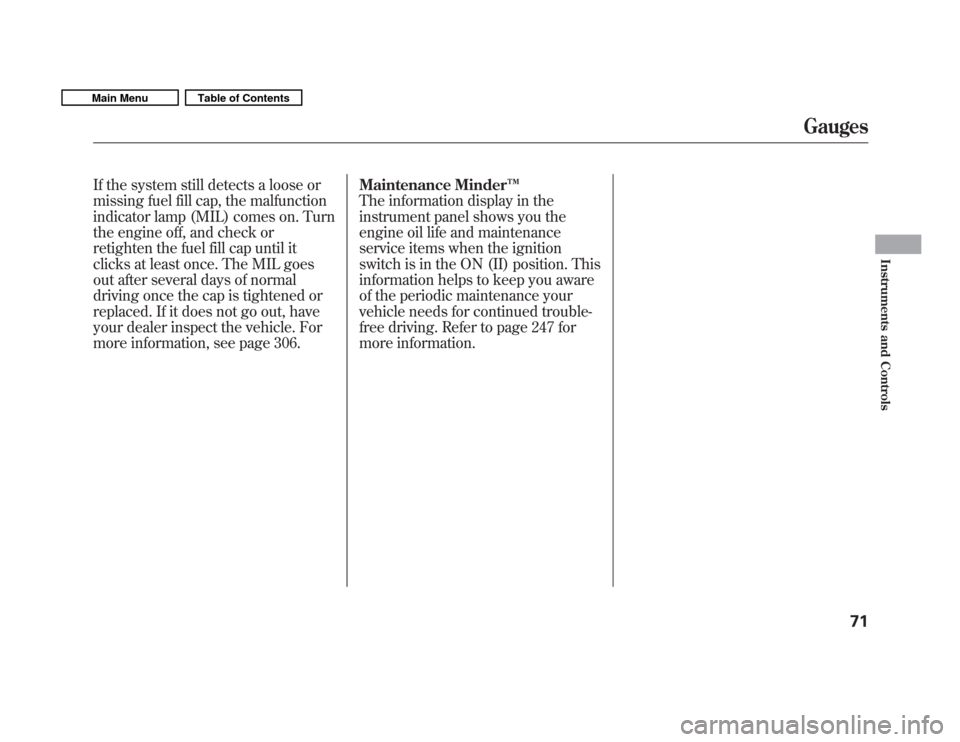
If the system still detects a loose or
missing fuel fill cap, the malfunction
indicator lamp (MIL) comes on. Turn
the engine off, and check or
retighten the fuel fill cap until it
clicks at least once. The MIL goes
out after several days of normal
driving once the cap is tightened or
replaced. If it does not go out, have
your dealer inspect the vehicle. For
more information, see page 306.Maintenance Minder
™
The information display in the
instrument panel shows you the
engine oil life and maintenance
service items when the ignition
switch is in the ON (II) position. This
information helps to keep you aware
of the periodic maintenance your
vehicle needs for continued trouble-
free driving. Refer to page 247 for
more information.
Gauges
71
Instruments and Controls
Main MenuTable of Contents
Page 206 of 356
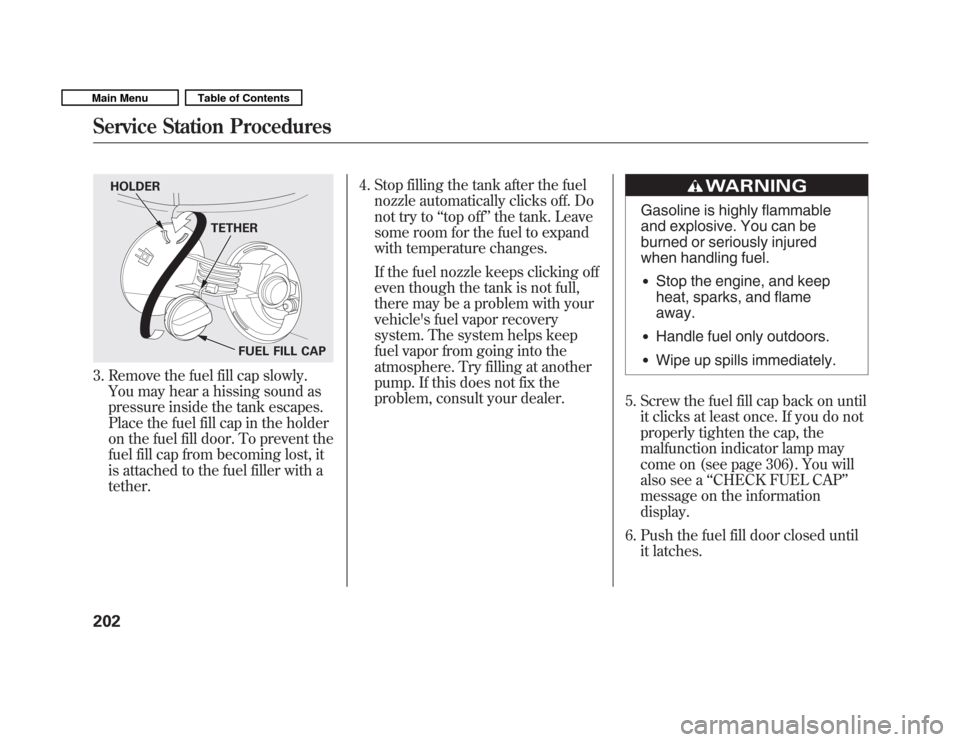
3. Remove the fuel fill cap slowly.You may hear a hissing sound as
pressure inside the tank escapes.
Place the fuel fill cap in the holder
on the fuel fill door. To prevent the
fuel fill cap from becoming lost, it
is attached to the fuel filler with atether. 4. Stop filling the tank after the fuel
nozzle automatically clicks off. Do
not try to ‘‘top off ’’the tank. Leave
some room for the fuel to expand
with temperature changes.
If the fuel nozzle keeps clicking off
even though the tank is not full,
there may be a problem with your
vehicle's fuel vapor recovery
system. The system helps keep
fuel vapor from going into the
atmosphere. Try filling at another
pump. If this does not fix the
problem, consult your dealer.
Gasoline is highly flammable
and explosive. You can be
burned or seriously injured
when handling fuel.
� Stop the engine, and keep
heat, sparks, and flameaway.
� Handle fuel only outdoors.
� Wipe up spills immediately.
5. Screw the fuel fill cap back on until it clicks at least once. If you do not
properly tighten the cap, the
malfunction indicator lamp may
come on (see page 306). You will
also see a ‘‘CHECK FUEL CAP ’’
message on the information display.
6. Push the fuel fill door closed until it latches.
HOLDER
TETHER
FUEL FILL CAP
Service Station Procedures
202
Main MenuTable of Contents
Page 259 of 356
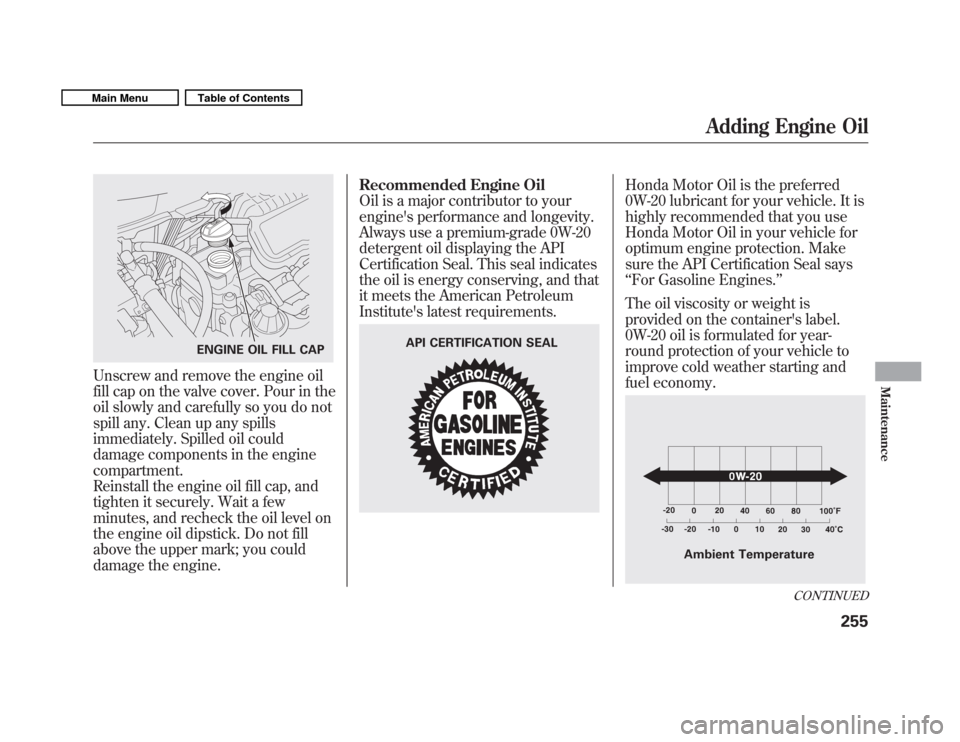
Unscrew and remove the engine oil
fill cap on the valve cover. Pour in the
oil slowly and carefully so you do not
spill any. Clean up any spills
immediately. Spilled oil could
damage components in the enginecompartment.
Reinstall the engine oil fill cap, and
tighten it securely. Wait a few
minutes, and recheck the oil level on
the engine oil dipstick. Do not fill
above the upper mark; you could
damage the engine.Recommended Engine Oil
Oil is a major contributor to your
engine's performance and longevity.
Always use a premium-grade 0W-20
detergent oil displaying the API
Certification Seal. This seal indicates
the oil is energy conserving, and that
it meets the American Petroleum
Institute's latest requirements.
Honda Motor Oil is the preferred
0W-20 lubricant for your vehicle. It is
highly recommended that you use
Honda Motor Oil in your vehicle for
optimum engine protection. Make
sure the API Certification Seal says‘‘
For Gasoline Engines. ’’
The oil viscosity or weight is
provided on the container's label.
0W-20 oil is formulated for year-
round protection of your vehicle to
improve cold weather starting and
fuel economy.
ENGINE OIL FILL CAPAPI CERTIFICATION SEAL
Ambient Temperature
CONTINUED
Adding Engine Oil
255
Maintenance
Main MenuTable of Contents